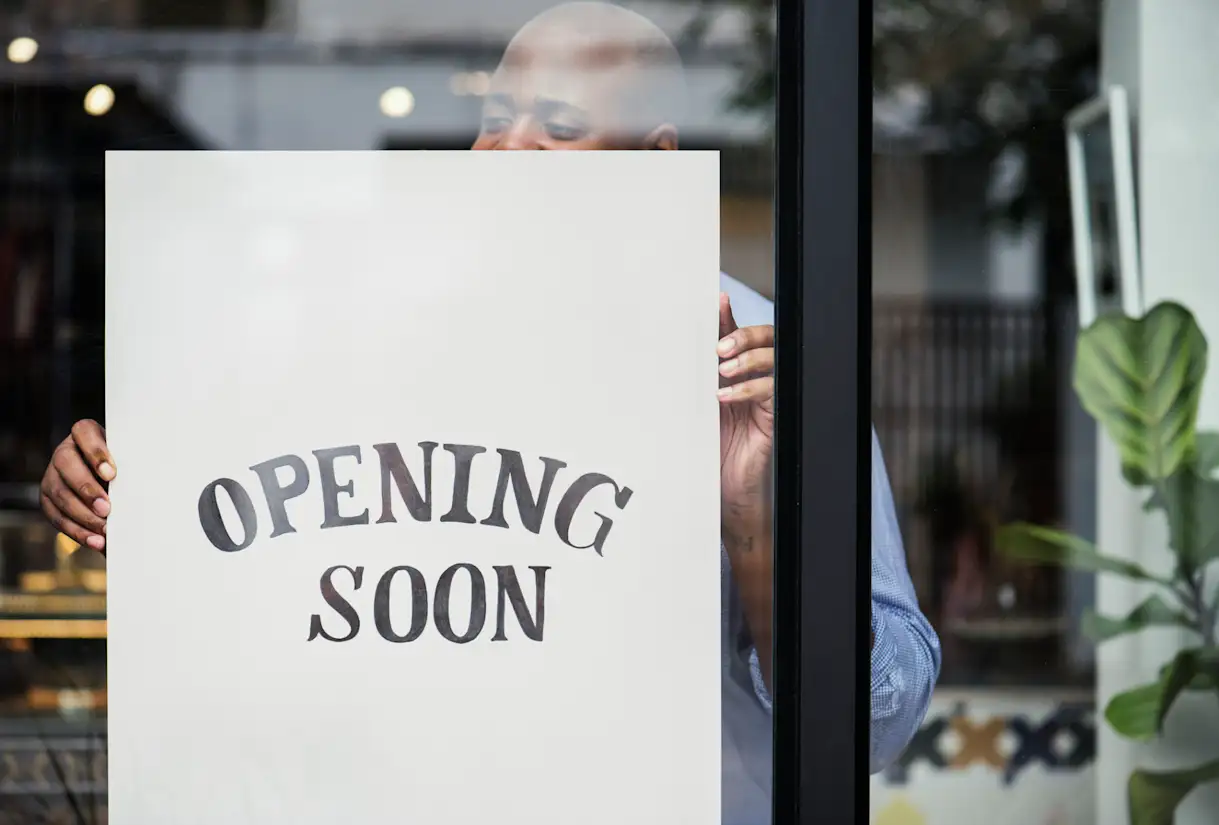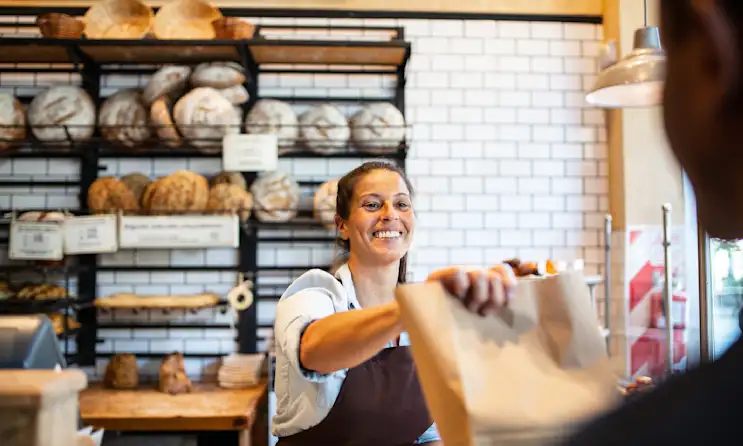New Openings
Restaurant Financing: 8 Strategies & Tips to Secure Funding
Learn about concrete resources and tips for getting funding for your new or existing restaurant business.
In a post-COVID era, opening a new restaurant might seem risky. After all, an estimated one in six restaurants in America closed during the first six months of the pandemic. But thankfully, the return to normalcy means diners are ready to return to dining rooms.
For entrepreneurs in the restaurant business, this is great news – demand for going out to eat is rising, meaning there’s plenty of opportunities to open new restaurants. But to get to a point where phones are off the hook and the line is out the door, a new restaurant needs to open up – and for that to happen, it needs restaurant financing.

RESOURCE
How to Open a Restaurant [Free Guide]
A step-by-step guide to planning, financing, staffing, stocking and marketing a new restaurant for its debut.
Why is Restaurant Financing Important?
Without seed funding, a restaurant cannot get off the ground. Procuring licenses, renovating the location, hiring and training staff, purchasing inventory and marketing the restaurant’s grand opening all require an investment of thousands of dollars before the business’s doors open on day one.
Other costs like franchising and consulting fees may also apply for certain restaurants, which can cost hundreds of thousands of dollars as well. Additionally, it can take several months or even years for a restaurant to break even. Funding during this time keeps a restaurant running until it becomes profitable.
The process of securing restaurant funding is also an essential step for first-time restaurateurs. It helps them understand their industry better and prepare for the expenses of a restaurant’s opening period since it’s nearly impossible to get financial backing for a restaurant without a completed business plan and a thorough understanding of the foodservice industry.
In short, the hunt for funding prepares entrepreneurs to become restaurateurs.
For existing restaurant owners, funding is a way to expand the current business. This capital can be used to open an additional location, renovate the restaurant or venture into new areas of business like catering and events service.

How to Get Restaurant Financing
Loans, grants, investments – there are several ways someone looking for restaurant funding can find it. However, each path comes with its difficulties, pros and cons. Some of the most popular sources for financing a restaurant are outlined below.
1. Small Business Administration Loan
A Small Business Administration (SBA) loan is intended to help a small business get its footing, with a certain amount of the loan guaranteed by the SBA in the event of the borrower’s inability to repay it. If going through one of the SBA’s preferred lenders, the process for loan approval can be handled within the institution – which can expedite the process of procuring capital by weeks.
There are several SBA loan options, but the most common one for restaurants is the SBA 7(a) loan. This loan can only be used for certain expenses, but fortunately, most of the major expenditures of opening a restaurant are eligible under a 7(a) loan, such as:
Restaurant equipment, like grills, walk-ins and ovens.
Purchasing a business by taking ownership of an existing restaurant.
Restaurant real estate to build, rent or purchase a space for the restaurant.
Pros of an SBA Loan
The SBA is designed to help (aspiring) small business owners succeed, so eligibility requirements are a bit more lenient than traditional bank loans. Also, if an application for an SBA loan at one preferred lender is rejected, that does not disqualify an applicant from seeking out a loan from another institution.
Cons of an SBA Loan
Like all loans, the down payment and interest rate can be a barrier to growing businesses. The lending institution will also want to see detailed documentation on the business and a formal application from the entrepreneur. Loan approval is not guaranteed or immediate.
Tip for Existing Restaurants
The SBA also has a dedicated Restaurant Revitalization Fund to “provide emergency assistance for eligible restaurants, bars and other qualifying businesses impacted by COVID-19.” Established by the American Rescue Plan Act, restaurant businesses may be eligible to receive up to $10 million in grants due to pandemic-related revenue loss. Click here to check eligibility.
2. Merchant Cash Advance
A merchant cash advance promises a set percentage of future sales in exchange for an immediate lump sum of restaurant funding. Companies that provide merchant cash advances basically lend the restaurant a set amount of capital in exchange for an amount of future sales greater than the advance amount. For example, if a restaurant receives an advance of $50,000 for a 10% markup, the creditor would be owed $55,000.
Merchant cash advances are often seen as a straightforward and relatively unrestricted source for restaurant funding – particularly for existing restaurants that do a lot of their business via credit card transaction.
Pros of a Merchant Cash Advance
Because merchant cash advances are paid back as percentages of sales rather than regular set amounts, it’s an ideal solution for restaurants that go through a slump. For example, if a seasonal summer restaurant needs emergency funding during the winter to fix equipment, the restaurant will pay back a smaller amount during the slower seasons and a larger amount as business picks up in the summer. This approach accounts for the expected ebbs and flows of business and can be easier on the restaurant’s bottom line.
Cons of a Merchant Cash Advance
Unlike loans, merchant cash advances can’t be paid back early to save on interest rates, meaning – for better or worse – the expected payback amount is set. Additionally, merchant cash advances are typically reserved for existing businesses, and bank statements for the business may be required before approval. Thus, this option isn’t ideal for financing a new restaurant. Finally, since the percentage of sale agreement is typically based on credit card sales (which are easier to track), restaurants that mostly do business in cash may not find this option to be the most favorable.
Alternative for a Merchant Cash Advance
Restaurants can also partner with a company like inKind, where instead of paying investors back with cash, inKind will resell the funding amount as gift cards to potential patrons for redemption at the restaurant. This method requires no interest or any forfeiture of ownership. Businesses like Two Hands have used inKind to finance their first location – and now, Two Hands is a fast-growing coffee shop in New York City. See how inKind works in the video below.
3. Crowdfunding
Crowdfunding involves using a site like Wefunder or Kickstarter to recruit the public to fund a restaurant idea. With Kickstarter, entrepreneurs set a monetary goal that – if met – charges everyone who backed the project with the amount of money they pledged. In return, those individuals are typically rewarded with gifts scaling in value alongside the size of their donations. Wefunder on the other hand, is equity crowdfunding, so your investors are rewarded - financially - through a payback structure (often a revenue or profit share, or a simple loan agreement).
This approach to community-based fundraising is beneficial to both businesses and their patrons, according to Jeff Dion, Founder Partnerships Lead at Wefunder. “We want founders to be able to have as many roads to raising capital on their terms, and in the timeframe in which they wish to,” says Dion. “We also want investors to be able to invest in whatever business they want, whether that's the next major startup, or for $100, their local coffee shop.”
While not all crowdfunding initiatives are successful, they can work (and have worked) in the restaurant industry -- “80% of raises are successful on Wefunder,” according to Dion. Harlan County Beer Company was a recent example of a successful revenue share fundraise on Wefunder. This Appalachian brewery raised $193K from 262 investors. In another example, Rhode Island-based Buttonwoods Brewery sought out $10,000 from the public with a 2017 Kickstarter campaign to get the taproom off the ground. Fast forward to 2021, and Buttonwoods is a thriving brewery in the greater Providence area.
Pros of Crowdfunding
Equity crowdfunding platforms like Wefunder are flexible models for acquiring funding. For example, on Wefunder, the business owner sets a minimum goal that must be met but then a maximum goal that does not need to be met. Campaigns can be open for up to six months, giving plenty of time for investors to find the business, invest and is key to achieving crowdfunding success. According to Dion, “if the goal is met, crowdfunding creates an army of brand ambassadors for the business.”
Wefunder, for example, allows community members to invest as little as $100 in a business they want to see succeed, and only charges a fee of 7.5% on the amount raised. Compared to other methods, crowdfunding fees are minimal.
As for Kickstarter, restaurateurs get to keep control of the entire company in exchange for inexpensive swag – and they don’t have to relinquish a percentage of ownership. Crowdfunding is also easier for restaurants that “already have paying customers and people who follow them,” according to Dion, due to their existing base of patrons and supporters.
Cons of Crowdfunding
Crowdfunding sites like Kickstarter run on an all-or-nothing model, meaning fundraisers that are not 100% met within 60 days receive none of the money pledged. This model can cause entrepreneurs to set lower-than-needed targets or risk failing in their quest for their desired amount of money.
Tip for Existing Restaurants
Crowdfunding is a legitimate fundraising strategy for restaurants in 2021 – particularly established ones – so any restaurateurs who are legitimately ready to raise funds, and want to explore this strategy, are encouraged to reach out to Wefunder’s Jeff Dion at jeff@wefunder.com.
4. Restaurant Investors
Restaurateurs can seek cash investments from venture capital (VC) firms or individual investors (aka “angel investors”). In exchange for financing the restaurant, investors typically ask for a percentage of ownership in the business based on the investor’s valuation of the restaurant’s worth. For example, if the restaurant needs $100,000 in funding and an investor provides that in exchange for 20% of the business, that investor sees the value of the restaurant as $500,000.
There are a few different ways to value a restaurant business’s worth, some of which are explained in this article.
Pros of Investors
Restaurant investors tend to have experience in helping a hospitality business succeed. Plus, with an ownership stake in the restaurant, these investors are incentivized to ensure the business grows and thrives, since the more money the restaurant makes, the more their share of the business is worth.
Cons of Investors
Most restaurants operate on a thin profit margin – particularly in the early days of the business – so diluting the restaurateur’s share of ownership is not the most desirable option. Investments in single-location restaurants may also be undesirable for investors, as according to Wefunder’s Jeff Dion, “equity routes have usually been challenging for restaurants – at least smaller restaurants or newer restaurants – to raise, because it's a funding strategy for businesses that have the potential to scale massively.”
5. Friends and Family
If all else fails, hopeful restaurant owners can reach out to their friends, family, and even former restaurant coworkers for help funding their venture. While this route might be seen as the scrappiest road to success, enlisting trusted colleges and loved ones to help build the business is still a viable option.
Pros of Friends and Family Funding
Family-owned restaurants are no rarity, and for good reason: the partner is invested not only in the success of the business, but also the business owner. Also, while these mom-and-pop establishments are typically single-location restaurants, it’s entirely possible for them to expand past a small-town setting. After all, Panda Express – the nation’s largest Asian restaurant chain – remains family-owned to this day.
Cons of Friends and Family Funding
Mixing business with pleasure can be a recipe for disaster. If the business does not succeed, it could damage personal relationships and create a financially-driven rift between the entrepreneur and anyone who invested in the restaurant.
Tips for Getting Restaurant Financing Faster

There are plenty of sources for restaurant financing – but all of them can be squandered if an investor responds to a request with a stern “no.”
Before meeting with a potential investor, there are a few best practices to adhere to in order to maximize the chances of securing capital.
1. Have a Finished Restaurant Business Plan
The restaurant business plan is the most crucial document for opening a new restaurant. Investors – whether friends or strangers – will want to know that every factor has been considered by the entrepreneur.his is where the business plan comes in.
The business plan outlines a restaurant’s market overview, strategic initiatives and detailed financial projections to explain how and when a restaurant will become profitable. Without a finished business plan, an idea for a restaurant business is just that – an idea.
Restaurateurs can build their business plan with this free template from BentoBox.
2. Practice The Pitch
Whether it’s a formal presentation with investors, a meet-and-greet with a bank lender, or an introductory discussion with former co-workers, they all share the same starting point – the pitch. The pitch is a quick 45-90 second overview of the state of the business (or potential business). It’s what someone looking for funding should be ready to say without hesitation if an investor or lender starts off the meeting by saying “So, tell me a little bit about the restaurant.”
In this situation, the worst thing one can do is ramble on, repeat themselves unnecessarily or worse – draw a blank. A response like that can show a lack of ambition, confidence or direction, and will almost certainly set a bad tone for the rest of the interaction.
Instead, entrepreneurs should come prepared to succinctly and enthusiastically explain their restaurant, why they chose to pursue restaurant ownership, what makes the concept unique and what they are seeking as an investment. It’s worth rehearsing the pitch with close colleagues and business partners for feedback, as well as practicing the pitch several times. After all, practice makes perfect.
3. Prepare Answers for Common Questions
“How will you obtain a sufficient share of this densely populated market?”
“When will I see a return on my investment?”
“How did you arrive at that estimate?”
If the answer to any of the above questions is “I’m not sure,” the chances of securing restaurant funding decrease dramatically. Therefore, it’s a best practice to think of some of the questions potential investors may ask before they sign a check, then proactively develop clear and complete answers.
Having an answer to as many potential questions shows investors and lenders that entrepreneurs have done their homework. If not, it could mean the difference between securing restaurant financing and not.
Funding Your Restaurant
From seed money to open up a first location to investment financing for a planned franchise, restaurant funding is a key ingredient for a restaurant to grow. Fortunately, with no shortage of funding opportunities, restaurateurs have an opportunity to capitalize on the growing demand for dining out.
Existing restaurants can also seize the continued popularity of online ordering with a custom restaurant website with BentoBox. Click here to get a demo of BentoBox and learn how to bring your restaurant’s storefront online.

BentoBox Marketing & Commerce Platform
Want to stand out online? Let's chat.
Drive revenue directly through your website.
Recommended

New Openings
How to Open a Bakery: The 6 Key Steps
June 20, 2023
A step-by-step guide to planning, financing, designing, staffing, and marketing a new bakery.

New Openings
How To Expand Into A Multi-Unit Concept
June 30, 2017
Advice from The Meatball Shop, Tacolicious and Next Door on growing your restaurant business

New Openings
How to Find Restaurant Investors
June 14, 2017
Here are some tips and tricks from pros who’ve done it themselves.

